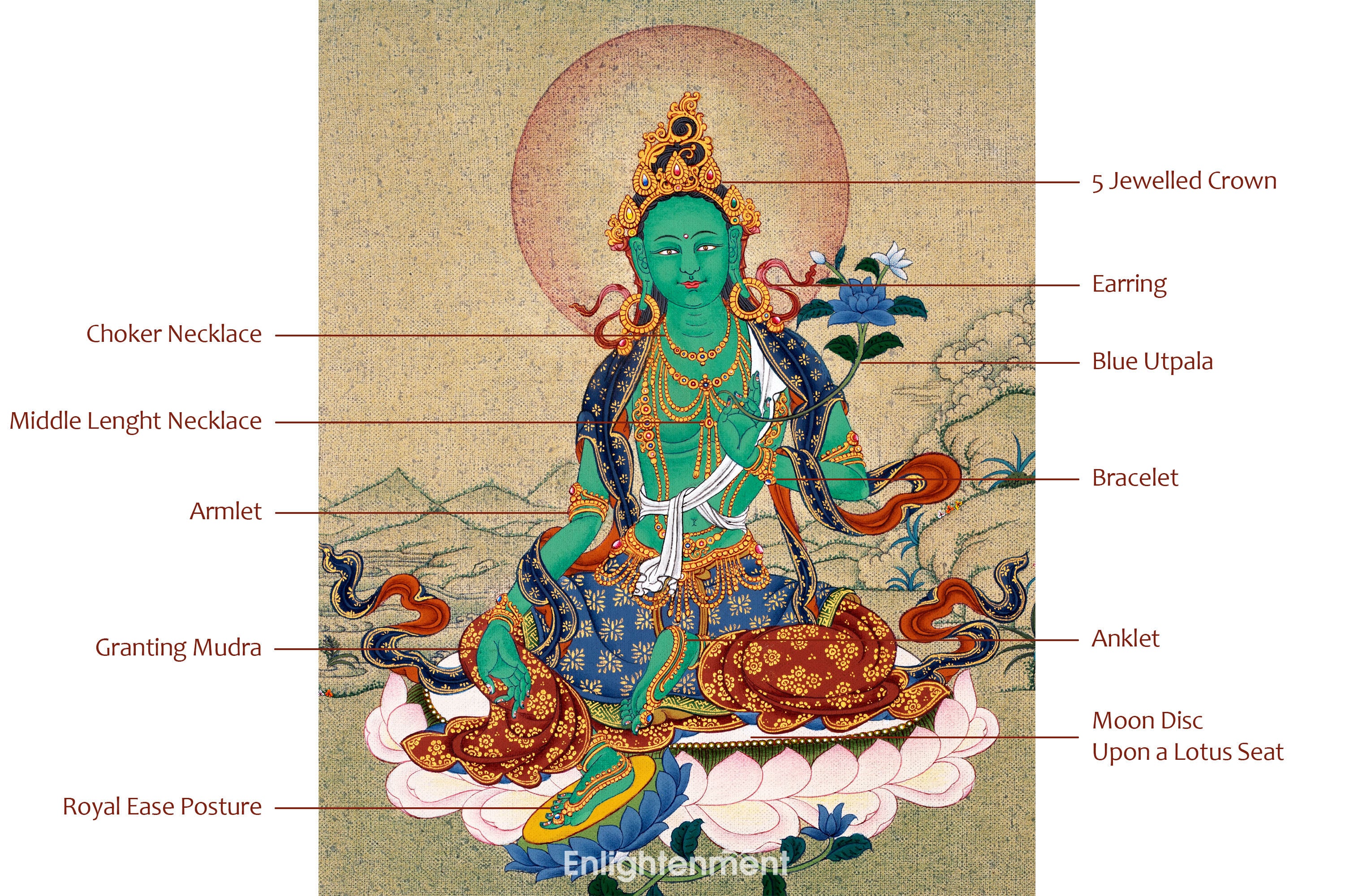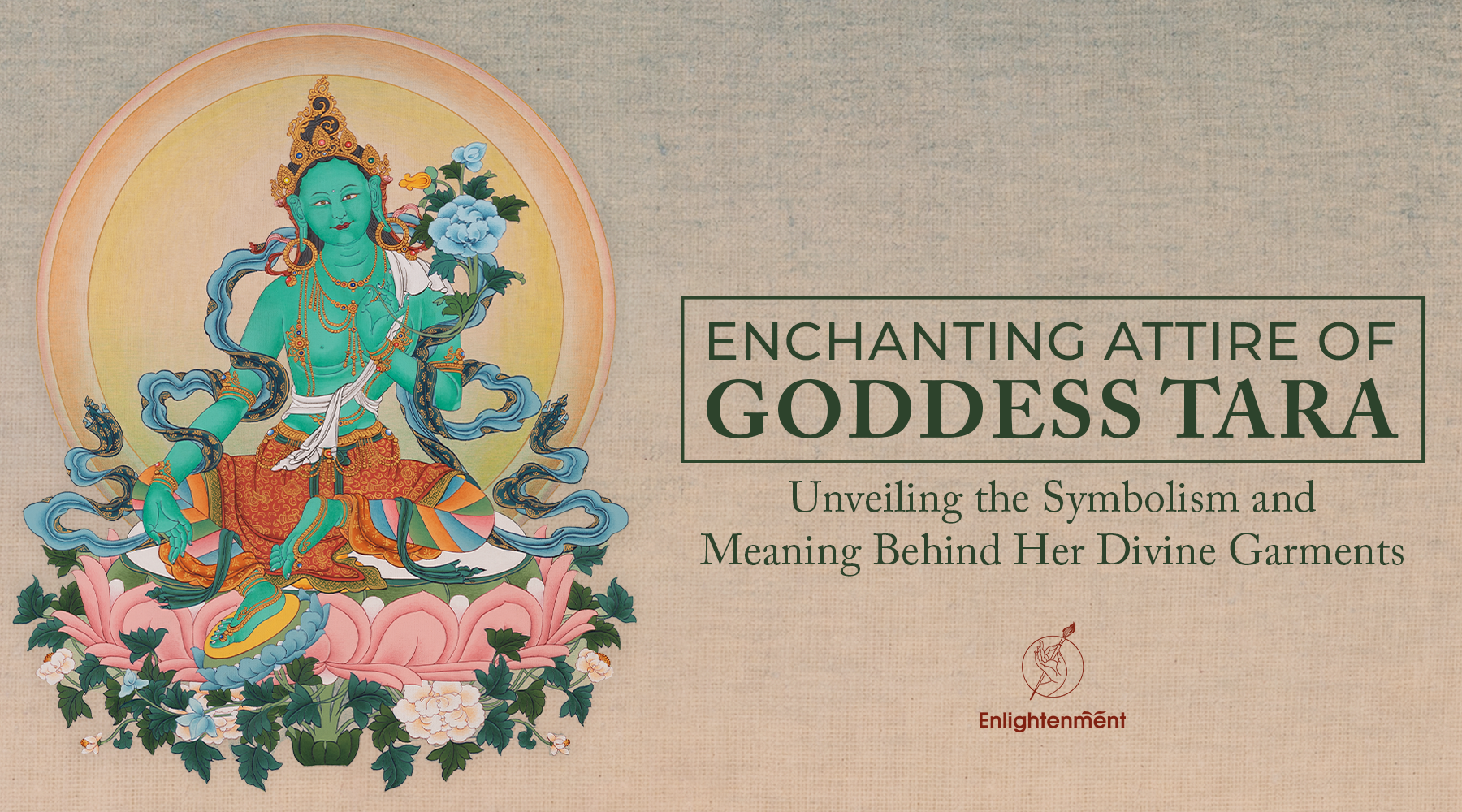Unveiling the Beauty: What does Tara Buddha Goddess wear?
Goddess Tara, also known as Sgrol-ma (Tibetan), is the female counterpart to the bodhisattva Avalokiteshvara, one who is destined for Buddhahood, hence resonates his essence, i.e., boundless compassion and benevolence to her devotees. She embodies a myriad of manifestations that has captivated the hearts of many devotees around the world. With her 21 manifestations representing 21 different virtues necessary to attain Buddhahood, Goddess Tara has several depictions that portray her various divine charms and symbolisms. However, her ethereal beauty, grace, and mysticism remain constant in all of her different manifestations. Let us delve deeper into the world of Goddess Tara and explore the attire, adornments, and symbolisms significant to the Goddess's depictions adding to her allure.
General Depiction of Goddess Tara through all of her manifestations
Tara is symbolically believed to be incarnated in all virtuous women in the Tibetan tradition and famously believed to have incarnated, embodying the principles of Tara in the two princesses- the Chinese Princess and the Nepali Princess. Symbolizing purity and grace, she is depicted as a young woman of age 16. In most of her depictions, she is in a meditative posture with crossed legs and delicately holding blossomed lotus or Utpala, which symbolizes purity and enlightenment. She manifests in primary colors of green, white, yellow, red, black, and blue throughout her 21 manifestations with unique elements like items according to the particular form.
The peaceful Bodhisattva attire
In Buddhist Himalayan art, there are eleven distinctive manifestations or forms for both the male and female boddhisattvas that are known synonymously as "bodhisattva appearance," "peaceful appearance," "deva appearance," and "sambhogakaya appearance." These manifestations encompass all the bodhisattva or the enlightened and tranquil beings. The depiction of these bodhisattvas, namely of Avalokiteshvara, Manjushri, and Maitreya for the male bodhisattvas and Tara for the female bodhisattva, are diverse with variation in their possession of numbers of arms, faces, and other gestures or symbolic items. Still, in terms of their adornments and attire, they exhibit a consistent aesthetic that remains largely uniform across all the Bodhisattvas.
This consistent and uniform array of adornments and attire is called the 'thirteen exquisite ornaments,' which can be categorized into two groups: The eight ornaments and the five silken garments. These sets of garments and ornaments, meticulously depicted in Himalayan art, not only serve as aesthetic elements but also carry symbolic meanings, infusing the figures with deeper layers of significance and spiritual resonance. Let us look deeper into the two categories in the context of Divine Tara.
The eight ornaments of Goddess Tara 
Click here to view Hand-Painted High-Quality Green Thangka
These are a collection of precious embellishments that enhance the divine and aesthetical presence of the figure.
Crown: Crowns, usually jeweled, sit upon the head of the figure, suggesting a royal stature and enlightened wisdom. It represents her divinity and supreme authority over the realms she commands. While depicting the crowns of Tara in Thangka, paintings, and statuettes often use 24k gold, are embellished with gemstones, and are detailed with intricate patterns. Devotees can feel her omnipresence and guidance through her crown.
Anklets: Decorative anklets are worn around the ankles and beautifully adorned with intricate detailing, gemstones, and gold. These anklets symbolize grace and resonate with the rhythms of the universe.
Armlets: These are worn on the upper arms and serve as decorative ornaments, enhancing the figure's poise and gracefulness. They often feature beautiful precious gemstones and a golden finish in depictions.
Bracelets: Tara's wrists are adorned with this ornament, often crafted with intricate designs and embellished with gemstones symbolizing strength and protection. Thangkas paintings or statuette depictions of Tara also use 24k gold.
Earrings: The pair of earrings dangling through her ears showcase her exquisite beauty, adding a touch of allure and refinement to her depictions. This piece of ornament also symbolizes the hyper-attentiveness of the divine Tara. They feature dazzling gemstones, intricate patterns, and gold finishes.
Choker Necklace: This close-fitting necklace encircles the Divine Tara's neck, adding to her grace and beauty. It is an elegant adornment embellished with beautiful gemstones or gold finishes in depictions.
Middle Length Necklace: This is another ornament worn to adorn her neck but is a bit longer than a choker, which is also adorned with exquisite gemstones and finished with gold adding more grandeur to the figure.
Long Necklace: A lengthy necklace draped gracefully around her figure symbolizes prosperity and abundance. In most depictions, it also incorporates gold and other embellishments.
It is worth noting that variations exist in enumerating and categorizing these Thirteen Ornaments, with occasional mentions of additional items such as belts and girdles.
The Five Silken Garments of Goddess Tara
A selection of exquisite clothing items is depicted in Tara's depictions.
Blue Silk Scarf: This flowing scarf is made of fine blue silk that is gracefully draped around the Tara, symbolizing her elegance and refinement.
Crown Pendants in a Kaleidoscope of Colors: These colorful pendants adorn Tara's crown, adding a touch of splendor and regality.
White Upper Garment: A pristine white upper garment is worn by the figure, symbolizing purity and spiritual transcendence.
Lower Skirt Garment: This is a flowing and intricately designed lower skirt garment worn by Tara, adding fluidity to the overall aesthetic of the figure.
Sleeves (or Long Scarf) for Dancing: Elaborate sleeves or a long scarf, often depicted with flowing patterns, are draped around the body of Tara to convey a sense of movement and artistic expression.
Mudras, postures, and facial expressions of each 21 Tara
The 21 manifestations of Tara should be properly understood as the different aspects of the same quality. Therefore, some elements are constant and uniform throughout the 21 manifestations. All forms of Tara can be seen performing the 'Prithvi mudra,' a hand gesture of balance and harmony, with her left hand, and a ‘Varada mudra,' a hand gesture of charity and benevolence, with her right hand. She sits upon a moon disc lotus seat with her right leg extending a little, indicating her subduing any untoward phenomena that can cause a problem or cause hindrances in all her forms.
- Noble Lady Tara Nyurma Pamo: Depicted with a semi-wrathful expression and a Red complexion, she is also known as 'Pravira Tara,' who liberates all beings from the suffering of samsara. An utpala is placed beside her, upon which a white conch shell that curls clockwise sits.
- Noble Lady Tara Loter Yangchenma: Relating closely to Chenrezig (Avalokitesvara), she is also known as 'Candrakanti Tara.' Her depictions include a white complexion and seven eyes, indicative of her compassionate attention to all beings' suffering. Her Utpala flower has a clear mirror marked with the syllable HRIM radiating light.
- Noble Lady Tara Sonam Tobche: Relating closely to wealth and possession, she is also known as 'Kankavarna Tara.' She is depicted with a yellow or golden complexion representing the color of gold. She is depicted with two hands, three eyes, and Amoghasiddhi in her crown. She holds a blue utpala in her left hand.
- Noble Lady Tara Tsugtor Namgyalma: Depicted with a golden complexion, she is renowned as the Victorious Ushnisha, a Sanskrit term denoting the sacred topknot adorning the crown of a Buddha. Additionally referred to as "Ushnishavijaya Tara," she is portrayed carrying a nectar vase containing an elixir of immortality.
- Noble Lady Tara Wangdu Rigje Lhamo: Alternatively known as 'Humsvaranadini Tara' and 'Kurukulla,' she is depicted with a red complexion and dons a red garment representing her connection to the fire element and her ability to inspire passion and vigor. She holds two arrows and gems.
- Noble Lady Tara Jigje Chenmo: Also known as 'Trailokyavijaya Tara,' she is depicted with wrathful facial expressions and a dark red complexion. Jigje means "fierce and frightening," and Chenmo means "the great one," implying that she is the great, fierce Tara. An indestructible phurba, or a ritual dagger that conquers negativity surrounded by blazing flames and sparks.
- Noble Lady Tara Zhengyi Mithumba: Depicted with a wrathful facial expression and an open mouth, she manifests Tara associated with personal spiritual power. She is alternatively referred to as 'Vadipramardani Tara.' She has a dark blue complexion and can be seen holding a black urn containing the fundamental forces necessary to overcome negative energies and destructive forces while sitting on a sun disc that is sometimes blazing with flames.
- Noble Lady Tara Zhengyi Migyalma: She is depicted with wrathful facial expressions and a dark red complexion. A vajra enveloped in blazing fire rests upon her utpala, which serves as a purifying force, eradicating sources of trouble and disturbance.
- Noble Lady Tara Sengdeng Nagchi: Known as the "mother of all Buddhas," she is depicted with a green complexion and two arms, on occasion, four arms. A universal wheel ablaze with radiant and dynamic light can be seen upon her utpala flower that possesses the power to alleviate beings, employing suitable means according to their individual needs.
- Noble Lady Tara Jigten Sumle Gyalma: Alternatively referred to by the name 'Sokavinodana Tara,' she has a red complexion and is depicted with a victory banner upon her utpala flower that overpowers the gods of the desire realm.
- Noble Lady Tara Phagma Norter Drolma: She is depicted with a semi-wrathful facial expression and an orange complexion with a treasure vase signifying her abundance and ability to remove poverty placed upon her utpala flower.
- Noble Lady Tara Tashi Donje: Depicted with a peaceful facial expression, she has a yellow complexion and represents balance and harmony. An infinity knot on top of her utpala flower is her iconographic symbol.
- Noble Lady Tara Yulle Gyalma: She has semi-wrathful facial expressions and a dark red complexion. She is depicted with three eyes and an open vajra on top of her utpala flowers that radiates light, annihilating any wrongdoers.
- Noble Lady Tara Thronyer Chen: Closely related to the wrathful aspect, she is depicted with wrathful facial expressions and a black complexion. She is often portrayed with multiple arms. A pestle sits atop her utpala flower.
- Noble Lady Tara Rabzhima: Known for purifying negative energy and error, she is depicted with a peaceful and serene facial expression and a white complexion. She holds an utpala with a vase on top of it that washes away all evil deeds.
- Noble Lady Tara Rigngag Tobjom: She has a red complexion and can stop the harmful intentions of others, such as curses and spells. A crossed vajra can be seen atop her utpala flower, which can destroy curses and negativity.
- Noble Lady Tara Pagme Nonma: Associated with stopping violence, she is depicted with an orange complexion, a peaceful facial expression, and a golden stupa upon her utpala flower.
- Noble Lady Tara Maja Chenmo: Also called 'Prapusti Tara,' she is depicted with a white complexion and peaceful appearance. A rabbit-marked moon that sits atop her utpala flower represents her.
- Noble Lady Tara Dugkarmo: She is depicted with a simultaneously smiling and semi-wrathful facial expression. Her name means 'white umbrella,' so she is portrayed with a white umbrella atop her utpala flower.
- Noble Lady Tara Rito Loma Jonma: Known for her power to protect from epidemics, plagues, and illnesses, she is depicted with a golden red complexion carrying an uptala flower with a medicine-filled round vessel on top.
- Noble Lady Tara Lhamo Ozer Chenma: She is depicted with a sublime facial expression and a white complexion. The Tara that protects all sentient beings from negative energies and summons back all the vitalities, instilling us with positive energy, is symbolized by a golden fish atop her utpala flower.

